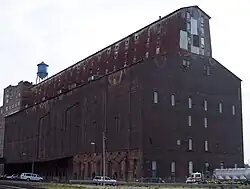Great Northern Elevator
The Great Northern Elevator was a grain storage facility at 250 Ganson Street in Buffalo, New York. The elevator was located on the City Ship Canal and at the time of its completion in 1897, the elevator was the world's largest.[1] The elevator was the first to employ cylindrical steel bins for grain storage, and also one of the first to run on electricity.[2] The brick curtain wall did not support the bins or the working house and was designed as weatherproofing only.
| Great Northern Elevator | |
|---|---|
 Great Northern Elevator before the brickwork collapsed. | |
| Former names | Mutual Elevator, Pillsbury Elevator |
| General information | |
| Status | Demolished |
| Type | Steel grain elevator |
| Architectural style | Vernacular |
| Location | 250 Ganson Street, Buffalo, New York, United States |
| Coordinates | 42.866725°N 78.87221°W |
| Construction started | March 31, 1897 |
| Completed | September 29, 1897 |
| Demolished | September 2022 - May 2023 |
| Management | ADM Milling |
| Height | |
| Roof | 187 feet (57.0 m) |
| Design and construction | |
| Developer | Great Northern Railway |
| Structural engineer | Max Toltz, D. A. Robinson |
| Main contractor | James J. Hall, Riter-Conley |
History
The Great Northern Elevator was built by noted Chicago elevator builder D. A. Robinson. Max Toltz, a bridge engineer with the Great Northern Railroad was the consulting engineer for the building and responsible for much of the building design. At the time of demolition, the building was the last of the "brick box" type working house grain elevators still standing in North America.[3]
Ownership
- The Mutual Elevator company bought the elevator from the Great Northern Railroad in March 1903.[3]
- In 1921, a local buffalo group named the Island Warehouse Corporation purchased the building and railroad right-of-way.[3]
- The Pillsbury Company bought the elevator in 1935 and operated within the facility until 1981.[3]
- In the 1990s Archer Daniels Midland acquired the building with the intention of demolishing it.
Storage
The Great Northern Elevator offered a total holding capacity of 2.52 to 3 million US bushels (89,000 to 106,000 m3) in 48 large steel bins. Thirty of the bins are 38 feet (12 m) in diameter and 18 of the bins are 15.5 feet (4.7 m) in diameter. The elevator's brick exterior serves as a weather barrier and does not help to carry the weight of the cupola or the grain bins. The building's structure is supported by a web of steel I-beams.[4] The building was originally equipped with three corrugated-iron nine-story-high iron legs designed to move along tracks. These were destroyed during a storm in 1922 and replaced by two new 145-foot (44 m) marine leg towers built by the Monarch Engineering Co.[3] A concrete framed flour mill addition was erected in 1924.

Present day
In the late 1980s, then-owner Pillsbury requested a permit to raze the structure. This was opposed, and culminated in the Great Northern's designation as a city of Buffalo landmark. In 1996 and 2003 demolition of the building complex was again requested by subsequent and current owner Archer Daniels Midland (ADM). Both times it was denied.[5] The building remains one of the earliest surviving elevators in the Buffalo River District.
On December 11, 2021, during a wind storm in Buffalo, the north-facing wall of the building partially collapsed, exposing some of the innovative cylindrical grain bins inside.[6] On December 17, the City of Buffalo ordered the emergency demolition of the historic elevator.[7] The Campaign for Greater Buffalo History, Architecture & Culture sued the city and owner ADM in State Supreme Court to block the demolition. The court found for the City and owner, whereupon the Campaign appealed to the fourth District Appellate Court. New York State appellate justice Tracey Bannister[8] granted a temporary restraining order against demolition.[9] Demolition began in September 2022.[10]
Gallery
 1985 photo
1985 photo Detail of distribution chute
Detail of distribution chute Detail of Westinghouse electric motor
Detail of Westinghouse electric motor_elevator%252C_looking_south_down_city_ship_canal%252C_electric_elevator_in_background_left._-_Great_Northern_Elevator%252C_250_Ganson_Street%252C_Buffalo%252C_Erie_County%252C_NY_HAER_NY%252C15-BUF%252C32-1.tif.jpg.webp) Great Northern (mutual) elevator, looking south
Great Northern (mutual) elevator, looking south.png.webp) Survey cross section
Survey cross section Distribution level, looking north
Distribution level, looking north Basement level, bottom of main bins
Basement level, bottom of main bins September 17, 2022 Saturday. This view shows the North face the day after demolition crews used a shear to rip apart one of the exposed metal bins.
September 17, 2022 Saturday. This view shows the North face the day after demolition crews used a shear to rip apart one of the exposed metal bins. Great Northern Grain Elevator Silo on 2 October 2022 after two weeks of demolition work.
Great Northern Grain Elevator Silo on 2 October 2022 after two weeks of demolition work.
References
- "12-A Great Northern Elevator (1990)". City of Buffalo. Retrieved January 5, 2013.
- "Great Northern Grain Elevator". LaChiusa, Chuck. Buffalo as History. 2002. Retrieved January 5, 2013.
- Leary, Thomas E.; Healey, John R.; Sholes, Elizabeth C. (1991). "Great Northern Elevator" (PDF). Historic American Engineering Record. Washington, D.C.: Library of Congress. Archived from the original (PDF) on November 3, 2012. Retrieved April 24, 2014.
- "Grain Elevators - How to see them (part 2)". Buffalo History Works. Retrieved January 4, 2013.
- Licata, Elizabeth (April 2011). "Preservation-ready: The Great Northern grain elevator". Buffalo Spree. Retrieved January 4, 2013.
- Reporter, Mark Sommer News Staff. "Great Northern grain elevator damaged by Buffalo windstorm". The Buffalo News. Retrieved 2021-12-12.
- Sommer, Mark (17 December 2021). "City orders emergency demolition of Great Northern grain elevator damaged in windstorm". The Buffalo News. Lee Enterprises. Retrieved 18 December 2021.
- Sommer, Mark (January 14, 2022). "Appellate Court Temporarily Stays Demolition of Great Northern". Buffalo News. Retrieved 2022-01-23.
- McKinley, Jesse (January 23, 2022). "Fighting to Preserve Towering Testament to Buffalo's History". New York Times. Vol. 171, no. 59312. p. A21. ISSN 0362-4331. Retrieved 2022-01-23.
- Carr, James (September 21, 2022). "Another Voice: Though Great Northern May Be Gon, It's Still Possible to Save Dart's Marine Legs". The Buffalo News. Retrieved September 23, 2022.
External links
- "Great Northern Elevator". SkyscraperPage.
- "Emporis building ID 311399". Emporis. Archived from the original on 2016-03-07.
- Historic American Engineering Record (HAER) No. NY-240, "Great Northern Elevator, 250 Ganson Street, Buffalo, Erie County, NY", 50 photos, 2 measured drawings, 33 data pages, 3 photo caption pages